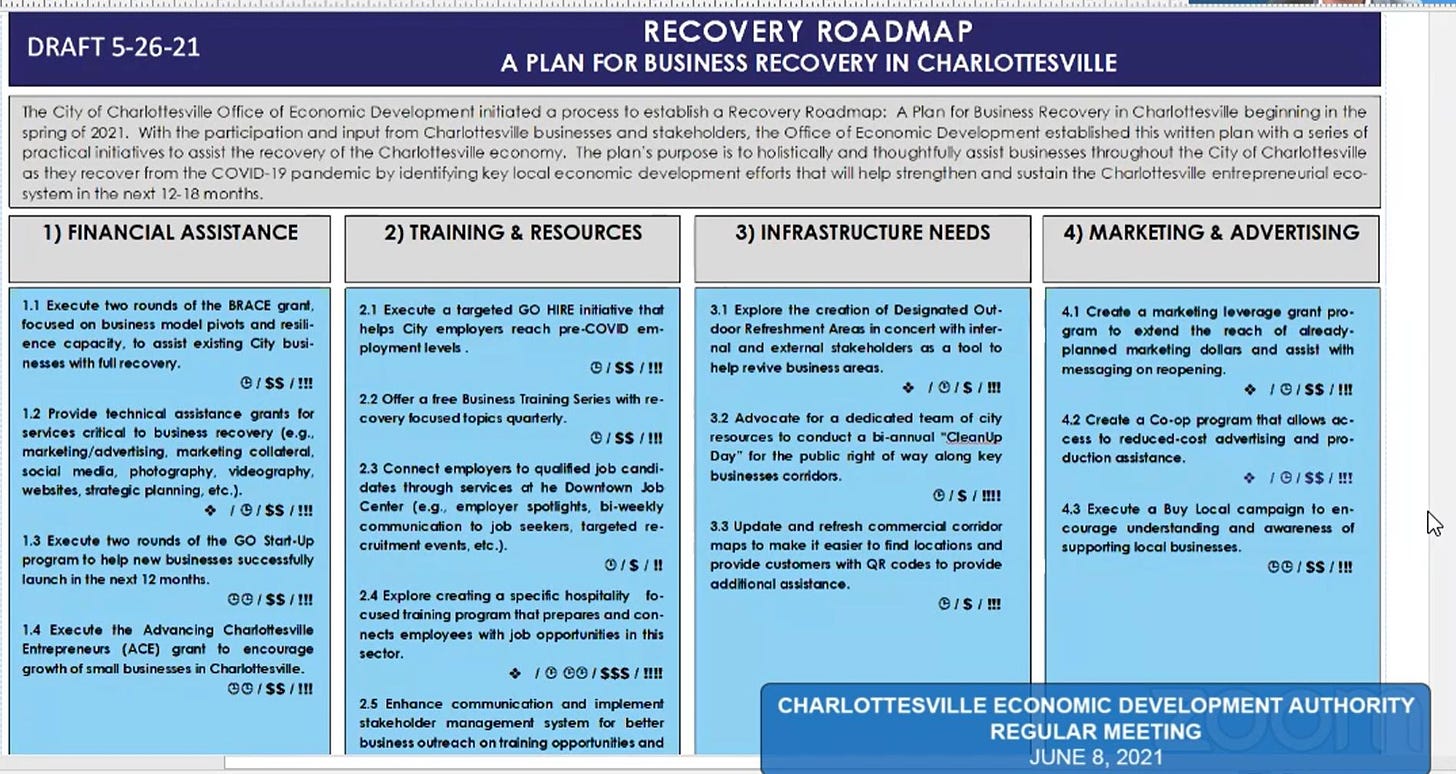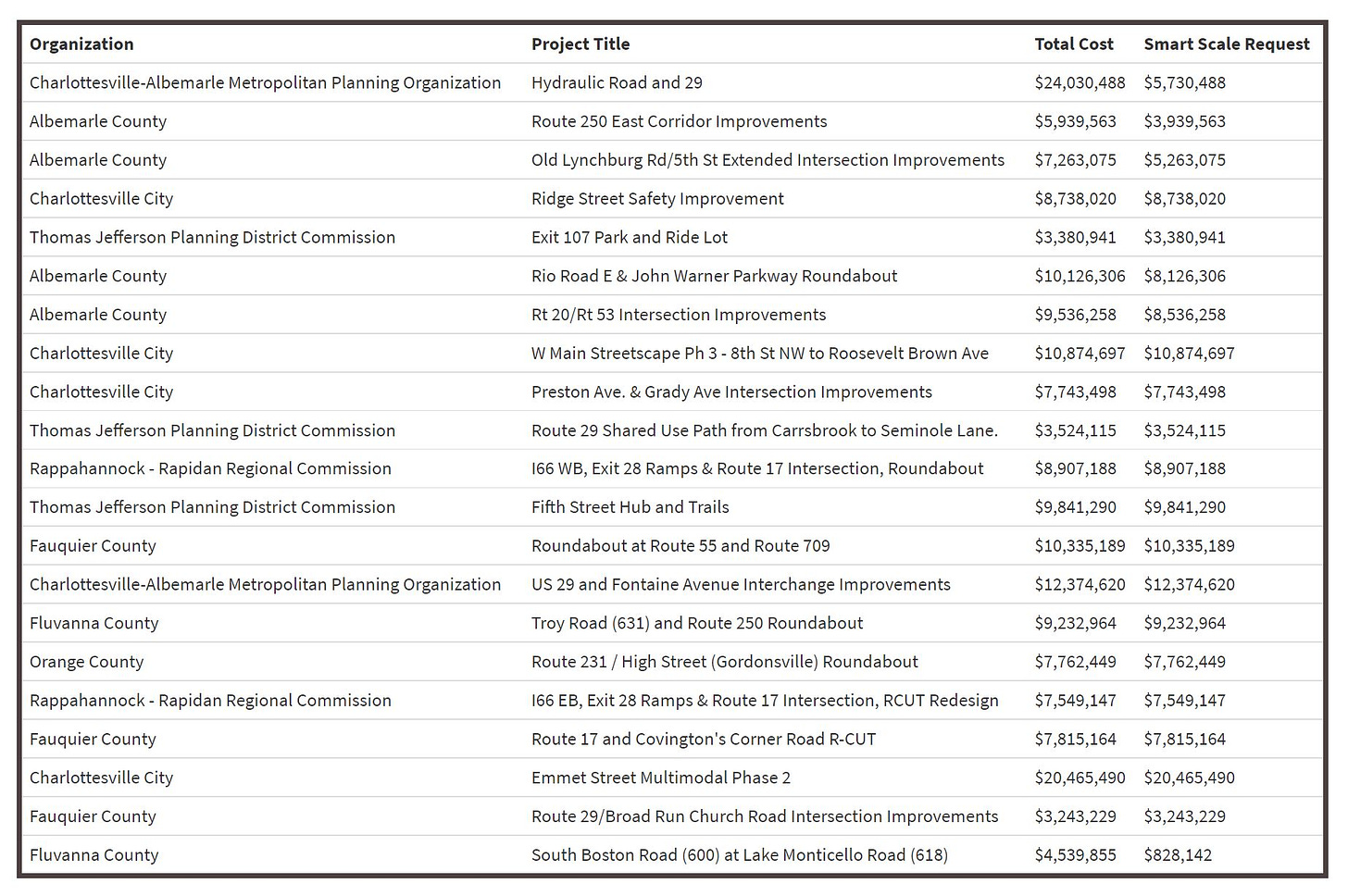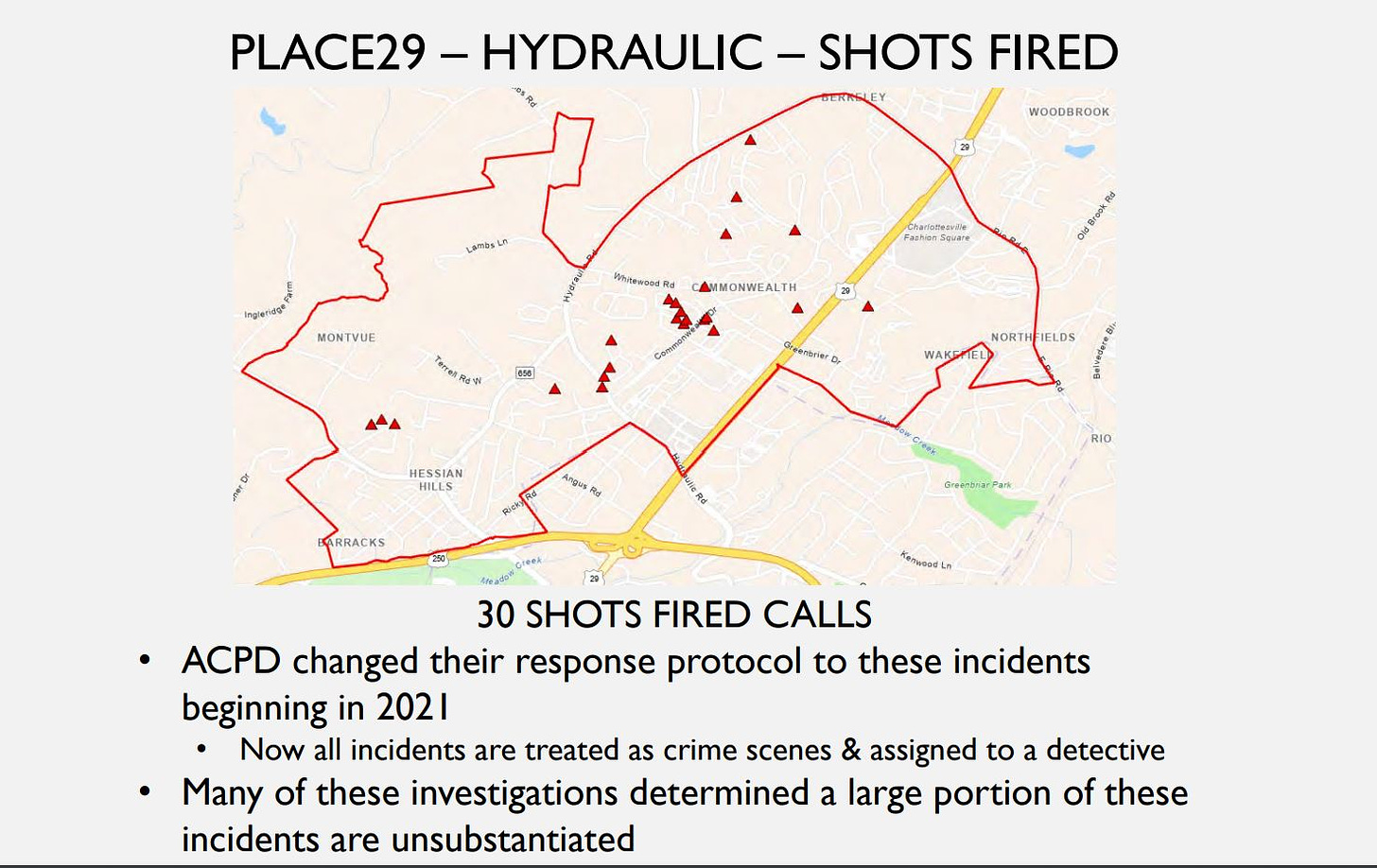Today's Patreon-fueled shout-out is for the Plant Northern Piedmont Natives Campaign, an initiative that wants you to grow native plants in yards, farms, public spaces and gardens in the northern Piedmont. Native plants provide habitat, food sources for wildlife, ecosystem resiliency in the face of climate change, and clean water. Start at the Plant Northern Piedmont Natives Facebook page and tell them Lonnie Murray sent you!
On today’s show:
Charlottesville City Council gets an update on city finances and economic recovery
Albemarle’s Places-29 Hydraulic panel gets an update on crime, climate, and Stonefield
A new round of transportation projects will move forward across the region
We begin today with Charlottesville City Council. As of today, there are only eight days left until the beginning of Fiscal Year 22. On Monday, June 21, the five elected officials got a glimpse of where things stand through the first eleven months of Fiscal Year 21. A shortfall related to the economic shutdown that began in Fiscal Year 20 is not as bad as initially reported.
“Based upon the current conditions of what we’re seeing in terms of revenues, things are continuing to trend in a positive direction,” said Ryan Davidson, a senior budget management analyst for the city.
In April, budget staff estimated there would be a $8.35 million gap, but revenues picked up and the current forecast is for a $7.42 million deficit for fiscal year 21. (staff report)
“We’re continuing to see some volatility month to month in some of our larger economic driven revenues,” Davidson said. “Sales, meals, lodging. But we’ve been seeing more of a positive trend in these areas.”
After the fiscal year, the accounts for FY21 will be audited which will take several months. The city will likely use a mixture of sources to make up the shortfall, including the American Recovery Plan Act (ARPA). Other options include the $7.3 million reserve set aside in previous federal funds and use of surpluses from previous years that have not been appropriated.
“Should we need to use the ARPA funds to cover any of the remaining budget variance that’s not covered by other means, we’ll know those figures after the close of the fiscal year and have those final audited amounts in the November or December timeframe,” Davidson said.

Let’s take a closer look at where the shortfalls are coming from. The adopted budget for FY21 estimated the city would bring in $14.3 million in meals taxes, $6.3 million from lodging taxes, and $1.34 million in income from parks and recreation. The current projections show the potential actual amounts as missing those targets by $3.5 million for meals, $2.6 million under for lodging, and $910,824 short for parks and recreation.
To get those numbers up for the soon-to-be-current fiscal year, the Economic Development Office is implementing a Recovery Roadmap and Economic Development Director Chris Engel provided an update on how it is going. (staff report)
“This process emanated out of a discussion the Council had at the beginning of the budget season late last year, November and December, where you indicated that helping businesses recover was one of your priorities,” Engel said.
Engel said there are 15 specific initiatives in the roadmap clustered in four categories. They are financial assistance, training and resource access, infrastructure needs, and marketing and advertising.
As of July 1, Virginia law pertaining to carrying alcohol outside of a licensed establishments will become more flexible to allow people to explore Designated Outdoor Refreshment Areas (DORA). Jason Ness is the Deputy Director of the Economic Development office.
“The designated outdoor refreshment area concept has been on the books with [Alcoholic Beverage Control Authority] for quite some time and really the fundamental change that takes effect on July 1 is that it is now localities have more control over these types of events,” Ness said. “In the past it was a permitted system both at the state and the locality. The new legislation will allow for cities to create ordinances to control these.”
Take a look at HB2266 if you want to see how what the legislation looks like and what it does. Ness said there would still be restrictions.
“You couldn’t take a cup from one ABC license holder to another, so you could not go from restaurant to restaurant but you could go into retailers if they would allow that,” Ness said.
Ness said the city is in talks with the Ix Park for a community block party for this fall. One idea would be to get the local DORA ordinance in place to allow that to be extended to the Downtown Mall.
Mayor Nikuyah Walker expressed concern that inviting alcohol consumption across a wider geographic area could lead to behavioral issues as well as unequal treatment.
“We’ve had a lot of concerns about drinking in public, drunk in public, those types of conversations,” Walker said. “I am hoping that we resolve those and that we’re not allowing some people just because they’ve purchased it in a restaurant when we know that other people are already drinking and there is different treatment.”
Councilor Michael Payne said he was open to the idea and shared Walker’s concerns.
“I couldn’t say that I’m 100 percent behind it at this point,” Payne said.
There was enough support from Council to give Engel the go ahead to work on pursuing an ordinance. Ness said he heard the concerns of Payne and Walker.
“Those are the important questions that we need to consider and flesh out all the answers on how things like that are going to be handled before we actually put that into place,” Ness said.
Vice Mayor Sena Magill said if the city seeks to explore a DORA then it needs to be about more than just one place.
“If we’re developing something like this, I don’t want it to be Mall-focused,” Magill said. “I want to make sure that if we’re developing it, that it can be developed for all areas of Charlottesville.”
Under the legislation, localities could set up three DORAS to explore.
Other ideas in the Recovery Roadmap include a twice-yearly clean-up day to address maintenance issues identified by businesses as well as a buy local effort.
Engel said his office is making a request for $1 million in American Rescue Plan funding to help boost the tourism sector. Part of that money would be used to replace revenue losses that have led to a decrease in available funds for the Charlottesville-Albemarle Convention and Visitors Bureau
“The Visitors’ Bureau revenue due to the transient occupancy tax in the city and [Albemarle] has been reduced by about $1.5 million and since the city and the county both fund that entity, the request that we’re both making through the ARP process if for half of that,” Engel said.
Walker asked whether this use of the ARP funding was the highest priority.
“If we do give those dollars, the $750,000, what are they used for and how do weigh the direct aid to businesses against the money to CACVB for their loss?” Walker asked.
Engel said the budget for the Visitors Bureau is based on previous years, so they won’t feel the effects until the new fiscal year begins.
“The funds are intended to replace the drop for next year and the year after,” Engel said.
Councilor Payne also questioned whether the city should use its share of the ARP funding to make up the losses. He suggested the General Assembly could vote later this summer to appropriate state money for the purpose of tourism marketing.
“If that money doesn’t come, or doesn’t cover the gap, I’m very curious to know what data and research exists about what is the actual return on investment to the tourism board and what return on investment do we actually expect and anticipate, recognizing that the ARP money is limited and its all about trade-offs and ensuring that we’re making an investment that’s having the most positive impact on our community,” Payne said.
Engel said if the General Assembly did allocate funding to tourism, it would most likely be in the form of grant funding and not a direct replacement of lost funds. He said he would return to Council with information along the lines that Payne requested.
I’ll have more from the rest of the Council meeting in a future newsletter.
The Charlottesville-Albemarle Convention and Visitors Bureau next meets on June 28.
The Commonwealth Transportation Board meets today and tomorrow virtually and in Richmond. The appointed body today coted to approve the Six-Year Improvement program for fiscal year 2022 through 2027, and that includes transportation projects in our area that come through the Virginia Department of Transportation’s Smart Scale process.
In all, 21 projects submitted in the VDOT’s Culpeper District have been recommended for funding, including a pedestrian bridge across U.S. 29 that would connect Stonefield with the Seminole Square Shopping Center. That project included funding left over from the Route 29 Solutions suite of projects and the CTB will vote to allocate an additional $5.7 million to allow it to move forward to the design phase.
Other projects include $5.3 million for a roundabout at Old Lynchburg Road and 5th Street Extended, $8.74 million to add safety improvements on Ridge Street, and $10.1 million for a roundabout at the John Warner Parkway and Rio Road East.
Smart Scale applications from across the Commonwealth are ranked according to a series of metrics including addressing safety, relieving traffic congestion, and providing economic development. The initial scores were released in January as I reported back then.
You’re reading Charlottesville Community Engagement, and it’s time for another subscriber-supported public service announcement. The Rivanna Conservation Alliance is looking for a few good volunteers to help out on Clean Stream Tuesdays, a mile and a half paddle and clean-up to remove trash and debris from popular stretches of the Rivanna River. Trash bags, trash pickers, gloves, and hand sanitizer/wipes will be provided, though volunteers will need to transport themselves to and from the end points. Kayaks for the purpose can be rented from the Rivanna River Company. Visit the Rivanna Conservation Alliance's volunteer page to learn more about upcoming dates.
The Places29-Hydraulic Community Advisory Committee met on June 21 for a wide-ranging meeting that began with an update on crime statistics from a new county employee.
“My name is Andrew Friedman and I am the new crime analyst here with the Albemarle County Police Department,” Friedman said. “I am new to the county as well and I actually live within the area that we’re going over today.”
Friedman’s report was intended to cover the area within the jurisdiction of the CAC, but he gave some overall trends.
“We see that property crime has been trending upwards since 2018 in the county at least whereas violent crime has been trending downwards,” Friedman said. “This matches the trend that we do see nationally.”
In an area that is slightly bigger than the Places29-Hydraulic area, there have been 134 property crimes through June 14.
“We’re talking about stuff like burglaries, we’re talking stuff like motor vehicle thefts, and largely led by larcenies,” Friedman said.
Of those property crimes, 21 were thefts of catalytic converters.
“Catalytic converter thefts are trending upwards,” Friedman said. “They’ve been increasing drastically in recent years throughout the nation and that’s because the material they’re made out of go for a lot on the black market. They would be pawned for a lot of money.”
Friedman said police departments across the region are working together against this specific kind of larceny.
Of the 14 violent crimes reported this year in the area, four were rapes and in all four cases the victims knew the offender. The 10 other crimes were aggravated assaults, and four of them were classified as domestic violence.
There were 30 calls for service in the area for shots fired this year. Friedman said most of these calls are unsubstantiated, meaning no shell casings are found. In one of the substantiated cases, one individual was struck by a bullet. Friedman said patrols have been stepped up in these areas. (watch the Places29-Hydraulic video) (view the full report)
The next topic at the Places29-CAC meeting dealt with two topics on the minds of many, though not necessarily at the same time. Climate change and growth management. Cynthia Neff is the chair of the CAC.
“Every now and then we need to refresh ourselves with what the growth management policy is,” Neff said. “The growth area is different [from] the rural area. The growth area is where the development is and the necessary housing is.”
There’s an entire chapter - Chapter 3 - of the county’s Comprehensive Plan dedicated to growth management, a policy that dates back to a Comprehensive Plan update in the late 70’s. Last October, the Albemarle Board of Supervisors adopted the first phase of a Climate Action Plan. Michaela Accardi is a planner with the county. (current Comprehensive Plan)
“The first objective in the county’s Comprehensive Plan is to consistently use the growth management policy as the basis on which to guide decisions on land-use, capital expenditures, and service provision,” Accardi said.
Around 95 percent of the county’s 726 square miles are designated as rural, and the rest is for development. Chapter 7 of the plan offers strategies for conserving land in the rural area and chapter 8 offers strategies for maximizing the use of land in the growth area. Objective four of the later chapter is to “Use Development Area land efficiently to prevent premature expansion of the Development Areas.”
In her presentation, Accardi also brought up some statistics included in Housing Albemarle, an update of the county’s housing policy that had a public hearing before the Board of Supervisors earlier this month.
“The median rent for rental units in 2019 was $1,278 a month and the income that a household will need to afford that rent is $50,640 a year,” Accardi said. “Approximately 31 percent of households in Albemarle have incomes less than $50,000.”
The Places29-Hydraulic CAC next heard from Gabe Dayley, the county’s new climate protection manager. In that role, he is the point person for Albemarle’s efforts to reduce greenhouse gas emissions.
“Emissions from vehicles traveling around burning gasoline is our highest slice of the pie in terms of greenhouse gas emissions in the community,” Dayley said.
If it’s expensive for people who work in Albemarle or Charlottesville to live there, meeting the goal of reducing carbon emissions by 45 percent by 2020 will be harder to accomplish.
“When housing is sometimes less affordable in a community but folks are working in that community, they may have to live in further outlying areas,” Dayley said. “That’s something that can increase traffic which has a variety of effects. One of those is larger greenhouse gas emissions.”
The Climate Action Plan has several chapters with strategies that seek to address specific areas of where emissions come from. One of these is on Transportation and Land Use which has the overarching goals of reducing vehicle miles traveled, shifting vehicles to those with lower or no emissions, reducing use of single-occupancy vehicles, and increasing transit, walking, and biking alternatives.
“Greater density can support fewer transportation emissions and better energy efficiency but that really requires a holistic approach to land use,” Dayley said. “Density, as well as mixed-use, where there’s maybe some businesses on the first floor serving local communities. Complete streets is a term that folks might have come across that has to do with the idea of a street that not just is functional for pedestrians and cyclists and cars and buses but is also pleasant and attractive for everyone to make use of.”
CAC member Vito Cetta said he was a supporter of the growth management policy.
“We have 1,200 to 1,500 people who move here a year and the Comprehensive Plan is really taking control of how we develop our county,” Cetta said.
However, Tom Olivier of the group Advocates for a Sustainable Albemarle Population said the county should limit the number of people who move to the community. Olivier lives outside of the Places29 area but made his comment at the end of the conversation.
“The primary drivers of greenhouse gas emissions are growth in both people numbers and gross domestic product and whether we add people to the development areas or to the rural areas, we add greenhouse gases and we also do that when we sort of expand economic activity,” Olivier said. “This is a very difficult issue, and basically I just wanted to say really I think there’s little chance of Albemarle County becoming carbon neutral if it doesn’t contain growth and I think that’s something the comp plan will have to address as we go forward.”
The Albemarle Board of Supervisors last updated the Comprehensive Plan in the summer of 2015 and a review and update is expected to begin in the not too distant future.


















Share this post